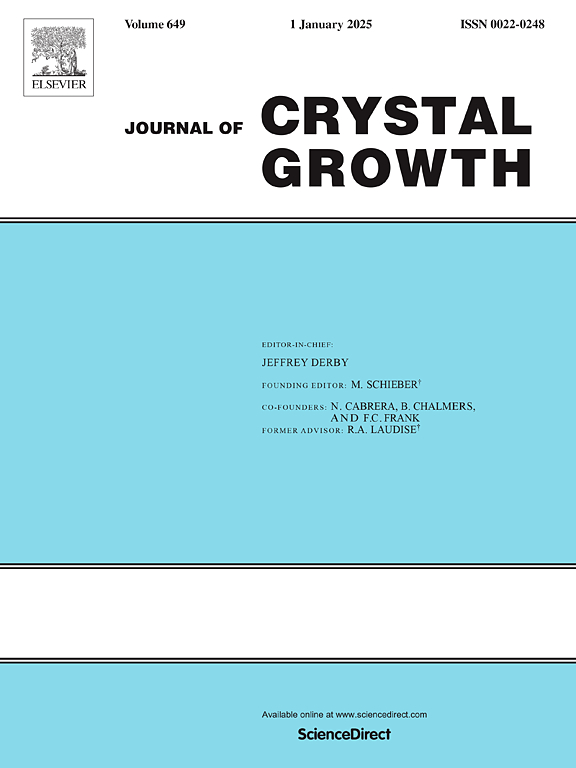Low-temperature ECR-PEMOCVD growth of β-Ga2O3 thin films on FTO/glass for potential vertical Schottky diode applications
IF 2
4区 材料科学
Q3 CRYSTALLOGRAPHY
引用次数: 0
Abstract
The low-temperature growth of β-Ga2O3 thin films on FTO/glass substrates was achieved using ECR-PEMOCVD with TMGa and O2 as precursors, and their structural, optical, and electrical properties were systematically investigated. XRD results reveal a clear evolution in crystallinity: as the substrate temperature increased from 350 °C to 500 °C and the discharge pressure decreased from 2.0 Pa to 0.5 Pa, the β-Ga2O3 films transitioned from amorphous to polycrystalline, eventually exhibiting strong (110) preferred orientation. XPS analysis confirmed the n-type conductivity of the films. A vertical metal–semiconductor–metal (MSM) Schottky diode based on Ni/n-type β-Ga2O3/FTO demonstrated a high rectification ratio of 1.57 × 103 at ± 4 V, a Schottky barrier height of 0.8–0.9 eV, and a carrier concentration of approximately 2 × 1016 cm−3. These results suggest that ECR-PEMOCVD is a promising approach for the low-temperature deposition of β-Ga2O3 thin films, with great potential for vertical device applications under limited thermal budgets.
FTO/玻璃上用于垂直肖特基二极管的β-Ga2O3薄膜的低温ECR-PEMOCVD生长
采用ECR-PEMOCVD,以TMGa和O2为前驱体,在FTO/玻璃基底上实现了β-Ga2O3薄膜的低温生长,并对其结构、光学和电学性能进行了系统的研究。XRD结果表明,随着衬底温度从350℃升高到500℃,放电压力从2.0 Pa降低到0.5 Pa, β-Ga2O3薄膜的结晶度由非晶向多晶转变,最终表现出强(110)择优取向。XPS分析证实了薄膜的n型电导率。基于Ni/n型β-Ga2O3/FTO的垂直金属-半导体-金属(MSM)肖特基二极管在±4 V下的整流比为1.57 × 103,肖特基势垒高度为0.8-0.9 eV,载流子浓度约为2 × 1016 cm−3。这些结果表明,ECR-PEMOCVD是一种很有前途的β-Ga2O3薄膜低温沉积方法,在有限的热预算下具有很大的垂直器件应用潜力。
本文章由计算机程序翻译,如有差异,请以英文原文为准。
求助全文
约1分钟内获得全文
求助全文
来源期刊

Journal of Crystal Growth
化学-晶体学
CiteScore
3.60
自引率
11.10%
发文量
373
审稿时长
65 days
期刊介绍:
The journal offers a common reference and publication source for workers engaged in research on the experimental and theoretical aspects of crystal growth and its applications, e.g. in devices. Experimental and theoretical contributions are published in the following fields: theory of nucleation and growth, molecular kinetics and transport phenomena, crystallization in viscous media such as polymers and glasses; crystal growth of metals, minerals, semiconductors, superconductors, magnetics, inorganic, organic and biological substances in bulk or as thin films; molecular beam epitaxy, chemical vapor deposition, growth of III-V and II-VI and other semiconductors; characterization of single crystals by physical and chemical methods; apparatus, instrumentation and techniques for crystal growth, and purification methods; multilayer heterostructures and their characterisation with an emphasis on crystal growth and epitaxial aspects of electronic materials. A special feature of the journal is the periodic inclusion of proceedings of symposia and conferences on relevant aspects of crystal growth.
 求助内容:
求助内容: 应助结果提醒方式:
应助结果提醒方式:


